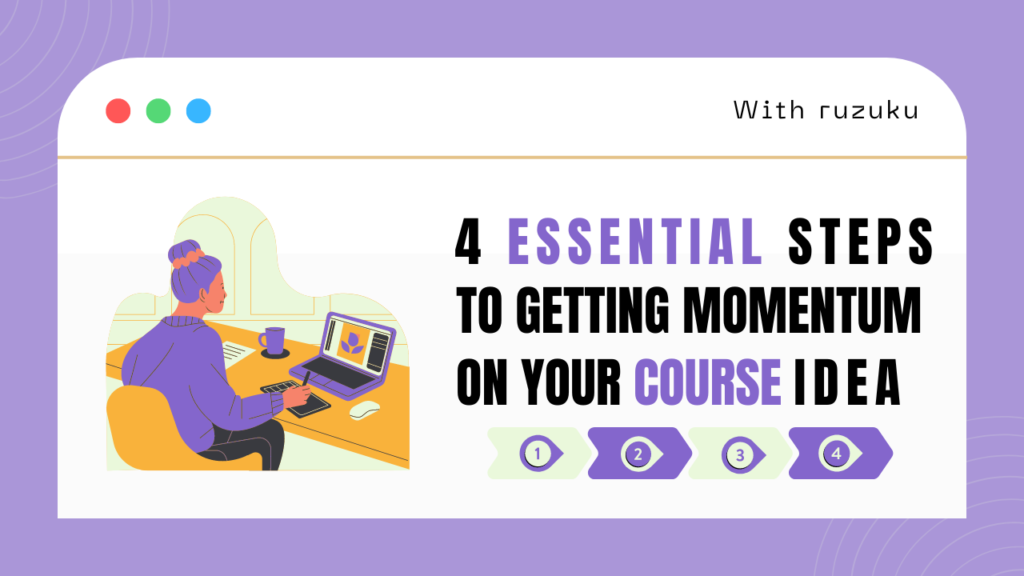Note to readers: This is the 4th post in our series about creating and launching your first course. If you’ve been following along, great! If you’re new here, you can read parts one, two, and three by clicking on the links.
You’ve done so much already to get your online course up and running.
You tested your idea and got initial validation that it was something people wanted.
You created a bare-bones outline of the course content.
You even figured out all of the structure and technology.
And now your first students are enrolled and waiting to hear from you.
So why does it still feel so terrifying to jump in and get started?
Maybe you’re worried that you forgot something important. Or maybe you’re just scared to step into the spotlight.
What if there are technical glitches?
What if you make a mistake? You don’t want to feel like an idiot in front of your students.
So you chew your fingernails and basically drive yourself crazy with worry about what might go wrong. And all of this worry does nothing positive — you’ve got students to teach and lives to change, after all!
But what if there was an easier way? A way to feel secure in your abilities as a teacher and to eliminate the stomach-churning anxiety about making mistakes?
We can’t completely eliminate that stress, but this post will get you most of the way there.
If you’d like to know how to run a worry-free pilot, read on!
Roll out the welcome mat
As soon as students join your online course pilot, make sure they know you’re glad they’re on board.
 Send a “welcome” email letting them know what to expect. If you use an email service provider like MailChimp or AWeber, this can be automated.
Send a “welcome” email letting them know what to expect. If you use an email service provider like MailChimp or AWeber, this can be automated.
In your email, let students know what they’ll learn from your pilot course, as well as what they’ll need to do to be successful, and how to get help.
Be sure to include the following details in your initial communication:
- Congratulations for enrolling in your course.
- A reminder of how their lives will improve once they start using their new skills.
- The date and time of their sessions and how to access each one.
- Homework or any other steps they will take action on right away (like joining an online community.)
- Milestones they should expect to reach.
- How to get support on course content or help with technical or account questions.
You might also consider holding a quick introductory or orientation call as an additional bonus.
The point is to set students’ expectations about what to expect from the course. Encourage them, establish a positive tone and give them a warm reception.
Start getting to know your new students
Later that day (or within two days at the latest), send your students a quick survey to get a feel for where they are right now so you’ll know how best to help them throughout your time together.
 It’s important to reach out while they’re still excited about joining your course and their motivations are still clear in their minds.
It’s important to reach out while they’re still excited about joining your course and their motivations are still clear in their minds.
You can use tools like Google Forms or Survey Monkey, or you might just send a personal email with a couple of questions. Either approach is fine.
Here are some questions you might ask:
- What are you most excited about learning in this course?
- What do you want your end result to be when you finish this course in X weeks?
- Is there anything else you’re looking to get out of the course?
- What caused you to sign up for this course?
- How much time each week are you able to commit to completing the course?
Questions like these help students think about what they want to accomplish. They also help students commit to achieving their goals and increase the likelihood that they’ll be successful.
Once you’ve gathered your responses, keep them handy as you develop and present your content. You’ll use what you learn about your students to make sure your content helps their specific situations.
Now you’re ready to actually run your course.
Run your pilot course like a champ
There are several essential steps to running any online course.
The first – and most important – is to make sure your technology is ready to go.
Prepare for the unexpected
Test your software. Test it again. Then triple-check to make absolutely sure.
 Recruit a few friends to help you do a short dry run.
Recruit a few friends to help you do a short dry run.
Make sure you understand things like how presentation mode works, how to share your screen, and how to allow students to ask questions if you’re doing a live class.
There’s nothing worse than technology that doesn’t work at the last minute. The more prepared you are, the less nervous you’ll feel and the more comfortable you’ll be with troubleshooting if something does go wrong.
If you’re using the Ruzuku platform, you won’t have many moving pieces to worry about. Still, it’s wise to make sure that you’re really comfortable with how everything works before that first class session.
You’ll be nervous enough just teaching your course material for the first time. There’s no reason to add additional tech stress to the list of things to deal with!
Next, have a plan to keep in touch.
Keep your students engaged
You can help your students stay interested, motivated, and taking action by sending frequent updates throughout your course.
Make sure to forward along:
- Any new or supplemental content that you want to share with them. Even if you talked about the topic on your call, someone will undoubtedly have missed it. Cover your bases by telling your students everything multiple times and in multiple places.
- Any updates you make to the course material based on their feedback.
- Requests for more feedback! Remember that one of the biggest reasons you are piloting your course is to make it the best learning experience possible. Acting on your pilot students’ feedback is the best way to ensure you reach that goal.
Congratulations! You’re ready to hop on your first call.
(Over)deliver on your promises
There is a simple formula for running great pilot calls. If you follow this general outline, you’ll cover everything you need to without worrying about overloading your students with too much information.
1. Introduce yourself and talk about the goal of the course.
This may feel repetitious to you, but your students need to be reminded of – and excited about – their end goal each time they meet with you.
2. Give a quick recap of what was covered in the previous session.
The exception will be the very first call. Reminding students of what they learned previously will help them retain the information they’ve already learned and also help them create context for what you are about to teach them.
3. Introduce the topic of the current session.
In other words, tell them what they’re going to learn. Briefly highlight the main points you will be covering during the call. This helps your students know what to listen for during the lesson.
 4. Deliver your lesson content.
4. Deliver your lesson content.
Teach them what they’re going to learn. This is where you really get to shine!
Use your bare-bones outline and teach them what they need to know to be successful. Remember, bare bones means the minimum amount of information necessary for your students to be successful.
Be careful not to overwhelm people with too much information or with advanced details they don’t need to worry about yet.
Make your content stand out by giving lots of examples (it’s hard to overdo this.) And tell stories that make your content memorable.
5. Recap the lesson.
Remind them what they just learned. Repetition is key to getting what you’re teaching to stick in their minds.
6. Tell them about any homework or action steps they should take before the next call.
This is also a good time to both encourage them and remind them that they have to take action if they want to see results.
7. Open the call up to questions.
Chances are, someone didn’t understand something that you talked about during the class. This is a great time for your students to clarify anything they’re confused about or would like additional information on.
You might even consider having a few questions in mind in case no one is brave enough to ask the first question. You can say, “I have a question that I received via email,” and open the conversation yourself.
As the calls progress, feel free to adjust this structure if needed, but this should provide a great starting place.
You will also have some work to do in between sessions.
Listen, engage, and be flexible
Even if your students ask questions during the Q&A, you’re still likely to get questions emailed to you during the week.
 Encourage them to contact you any time they have questions about the course material. You don’t want anyone sitting at home feeling stuck or frustrated.
Encourage them to contact you any time they have questions about the course material. You don’t want anyone sitting at home feeling stuck or frustrated.
Note where people get hung up, confused, or ask questions. Also keep track of their successes.
The places where students get stuck show you where your course can be changed or improved. When you supply additional explanation or change your teaching approach, you can increase their chances of successfully completing the course.
So be open to changing the pilot course as you learn what works and what doesn’t. Your students’ success is your most important goal.
Once your calls have wrapped up, you have one more important step to complete.
Wrap up your successful pilot course
Once your course is complete, gather some final feedback.
Keep the conversation going. By reaching out while the course experience is still fresh, you solidify your relationship with your students, and show you care about their results.
The best way to continue the conversation is to send a survey to find out about your students’ experiences with it.
 Here are some questions that you might ask:
Here are some questions that you might ask:
- Did you reach the goal you set at the beginning of the course? Do you feel good about your progress? Did you get your desired end result?
- What aspects of the course did you enjoy the most?
- How could this course be improved?
- Do you have any other comments or ideas about the course?
- Would you be willing to share a testimonial about the course (if yes, please be sure to leave your contact information).
Don’t forget to thank your students for being part of this experience. Assure them that their input has been valuable in building your course and that you appreciate it.
Finally, let them know what your future plans are and how they can keep in touch with you.
Again, you can use a tool like Google Forms or Survey Monkey to gather your responses.
Once you have finished up your calls and gathered all of your feedback, it’s time to celebrate a course well-run!
Change lives, one student at a time
Pilot courses are powerful things.
They let you test your ideas and have a positive impact on your audience at the same time.
And now you have the framework to run painless pilot sessions.
You know how to make your students feel welcome. You know how to prepare for the unexpected. And you know how to be flexible and adjust your methods as you go.
If the idea of actually running your pilot has been holding you back, now you’re ready to roll. No more excuses!
Your next step is to round up the students who are interested in your idea, and get your pilot going.
Have you considered running a test version of your online course? What’s been holding you back? Let us know in the comments!





6 Responses
You covered all the bases beautifully, Jessica — thank you!
Thanks so much, Summer! Always happy to hear from you!
Thank you! Much appreciated. 🙂
Thanks, Sassy!
This was extremely helpful. I really appreciate having such a concise outline for rolling out my course. It’s like making a painting or a work of art…it never feels “done” but at some point you have to say it is, launch it, and see how it goes.
Thanks so much, Jennifer! And yes – you could put off launching forever, waiting for perfect. Better to get it good, launch it, and then improve with the next iteration!